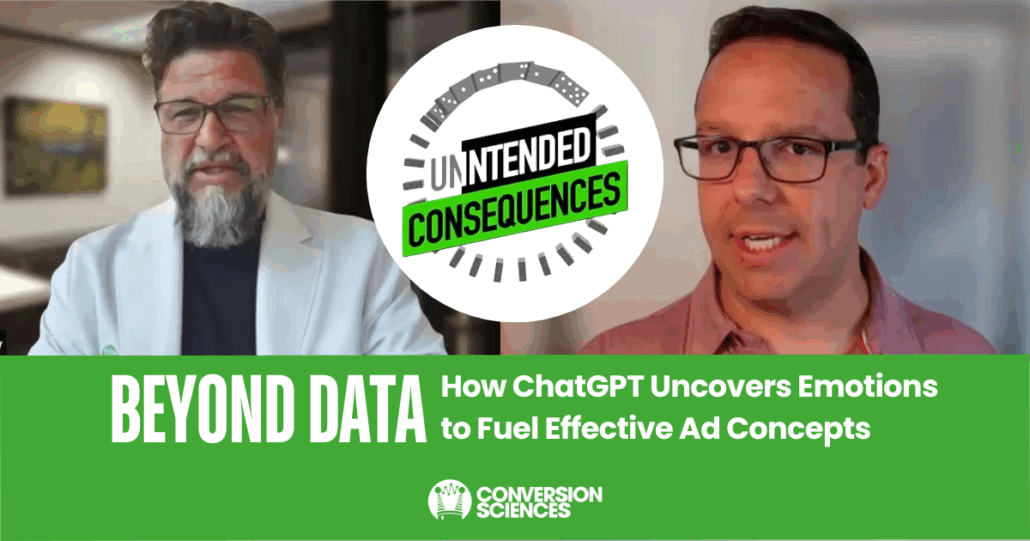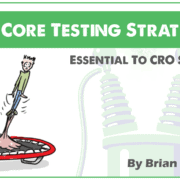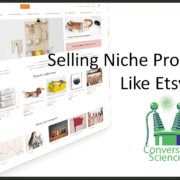Beyond Data: How ChatGPT Uncovers Emotions to Fuel Effective Ad Concepts with Joe Putnam [Podcast]
Emotions drive conversions — and in this episode of Intended Consequences, Brian Massey sits down with Joe Putnam, founder of Conversion Engine, to explore how top-performing ecommerce brands are using AI CRO strategies to scale faster, test better, and connect more deeply with their customers.
You’ll hear how Joe’s team analyzes customer reviews at scale to uncover emotional triggers, how they test ad angles that competitors often miss, and why a “boots that hurt” campaign might not be the golden angle you think it is.

🎧 Listen to the full episode here:
Podcast: Play in new window | Download
Ready to improve your ecommerce site’s performance? Learn more about Conversion Science’s fully-managed Ecommerce Optimization Services.
Why Emotions Still Win in Marketing (Even for Practical Products)
“People buy with emotion and justify with logic,” Joe explains — and it’s not just for luxury brands like BMW.
From cowboy boots to baby products, emotional triggers like trust, belonging, pride, and joy show up in customer language all the time. Even in seemingly utilitarian products like closet storage or bathroom scales, people make decisions based on how they feel about the product, not just what it does.
The key is knowing which emotional buttons to push, and that’s where AI CRO strategies come into play.
Finding Emotional Patterns
Sentiment analysis is the process of identifying the emotions behind the words people use — especially in product reviews, support tickets, and social comments.
Traditionally, marketers had to manually scan hundreds of reviews to pick up on these emotional patterns. Today, Joe’s team uses ChatGPT and other AI tools to streamline this process:
“We copy and paste hundreds of reviews into ChatGPT and ask it to do an emotional sentiment analysis,” Joe says. “What problems are being solved? What are people feeling? What language are they using?”
AI CRO strategies like this quickly surface pain points, unique selling propositions, and emotional value statements that can power ad copy, email campaigns, and landing pages.
Building an Emotional Connection
Once the team has pulled emotional themes from the reviews, they organize them into distinct messaging angles — each one reflecting a different emotional trigger. These angles might include:
- Trust & security: “I know these will last. Worth every penny.”
- Belonging: “I feel like I’m part of a community.”
- Confidence: “I walk taller when I wear these boots.”
- Joy & reward: “I bought these for myself as a gift. It felt amazing.”
Instead of just running ads that say, “Tired of boots that hurt?” over and over, Joe’s team builds multiple ads targeting different emotional angles. Then, they let the data reveal which message resonates most with the brand’s audience.
Takeaway: You’re probably underutilizing your customer reviews. With the right prompt, AI can uncover 3–5 powerful emotional angles you may have never tested.
Does AI-led Sentiment Analysis Work for All Products?
Yes, even for “boring” or utilitarian products. Joe explains:
“Whether you’re selling cowboy boots or closet storage, you’re always trying to tap into emotion. It might be fear, trust, anxiety, or satisfaction. But emotion is there. And when you find the right one, your results improve.”
Some products might lean into pride or aspiration. Others might connect through relief or peace of mind. In every case, the emotional experience is as important as the feature set.
Why AI Doesn’t Replace the Marketer
Let’s be clear: AI isn’t doing the job for you — it’s helping you do your job better.
Joe emphasizes that AI CRO strategies are a shortcut to better ideas, not a replacement for judgment:
“You still need human intelligence to decide which angles are worth testing, which copy resonates, and which ideas are off-brand. AI gives us more clay to mold — but we still have to be the sculptor.”
AI may generate seven ad angles. But maybe only two of them are good. With a trained marketing team, you can spot the winners, test them faster, and scale what works.
Additional Reading: How to Seamlessly Integrate AI Marketing Into Your Strategy
The Role of Landing Pages in Emotional Alignment
The best ads in the world can fail if the landing page doesn’t match the emotional promise.
One mistake Joe often sees: sending all ad traffic to the same product listing or category page, regardless of the ad’s message.
Instead, he recommends:
- Creating custom landing pages for different ad angles.
- Reinforcing the same emotional message from ad to landing page.
- Using customer language throughout the copy and CTA.
“If the ad is about personal pride or reward, make sure the landing page reflects that. That emotional consistency is what drives higher conversions.”
Mistakes to Avoid with AI and CRO
While AI can be powerful, it’s not infallible. Joe warns of a few key pitfalls:
❌ Mistake 1: Believing Every Insight is Gold
Not every insight generated by AI deserves to be tested. Use your experience and brand knowledge to filter the noise.
❌ Mistake 2: Ignoring the Landing Page
Even strong ads will underperform if the landing page doesn’t deliver on the emotional promise of the creative.
❌ Mistake 3: Over-engineering Prompts
You don’t need “prompt engineering” skills to make this work. Start simple:
“Conduct emotional sentiment analysis on these reviews.”
Let the AI do the heavy lifting — then dig deeper based on what it returns.
Quickstart Guide: How to Use AI in Your Ecommerce Ad Strategy
If you want to try this for your brand, here’s a simple way to get started:
- Collect Reviews – Grab 100–200 reviews from your product pages or Amazon listings.
- Drop into ChatGPT (or your AI of choice) – Use a prompt like, “Analyze these for emotional sentiment. What feelings are customers expressing? What problems are they solving? What language repeats?”
- Extract Emotional Angles – Look for clusters: trust, pride, satisfaction, relief, identity, etc.
- Translate into Messaging Pillars – Create 3–5 core messaging angles that represent your product’s emotional impact.
- Test in Ads and Landing Pages – Build multiple creatives — each aligned with a different pillar — and track which one drives the most engagement and conversions.
Final Thoughts: Emotions Scale. AI Speeds It Up.
The secret to ecommerce success isn’t just in your product specs. It’s in the emotional response you trigger. And now, thanks to AI, you can discover those responses faster than ever.
As Joe Putnam puts it:
“AI doesn’t give you the final product. But it gets you 80% of the way there — and helps you uncover ideas you wouldn’t find on your own.”
Want help turning sentiment analysis into high-converting campaigns? 🔬 Talk to a Conversion Scientist














